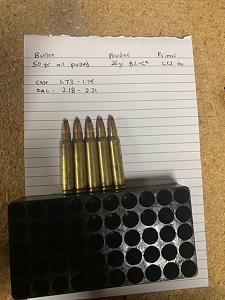So I have been kicking the thought of reloading ammo for years and have slowly accumulated things here and there to start reloading as a hobby. More so, to fuel my real hobby which is shooting.
I mainly run .223 and 9mm. Don’t get my wrong, I’ll shoot anything that goes bang but these two rounds in particular is what I carry everyday in law enforcement so I am wanting to get set up to reload LOTS of rounds in both.
I started with 5 rounds of .223. I didn’t load more because I want to test the load before I start mass producing. Here’s what I’m starting with
50 Gr military pull frangible bullets (they were cheap)
26 gr BL-C2
CCI 400 primers
The case lengths were all between 1.74 and 1.75, which I’ve read it’s ok to be off by .01, the trim length for .223 being 1.75.
The OAL range from 2.18 to 2.21. My press is set up for 2.21 and the reason for the shorter rounds is that some of the pulled bullets have the tip smashed down. Herein lies my question that I can’t seem to find an answer to. I’m aware the max OAL is 2.26 but I can’t find anything on a minimum OAL. Or does this even matter? All of the rounds chamber and eject and aren’t for precision shooting. I want them to be accurate enough that I can run and gun with on the range but I’m not out to win any competition with these rounds.
Will I be ok to run these through a rifle without damaging it? It has a 16” barrel if that matters.
On another note, I’ve noticed the federal .223 brass is all crimped at the primer with the ring crimp. What do you guys use to remove these when reloading a lot of ammo in a sitting.
Thanks for any advice
Tony


|
   
   
|


|



 Reply With Quote
Reply With Quote





















